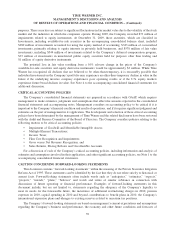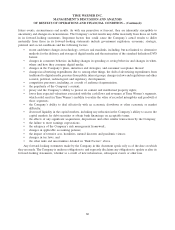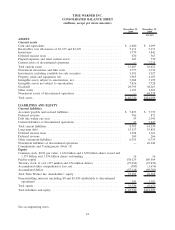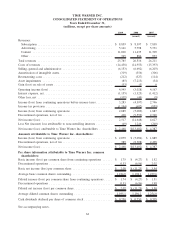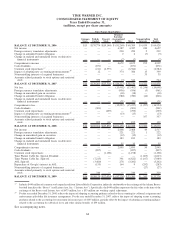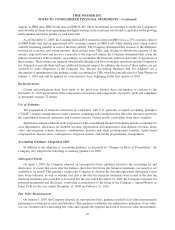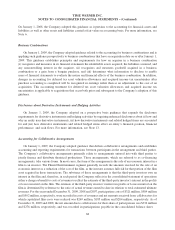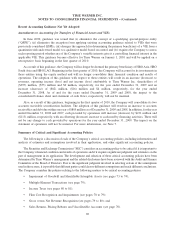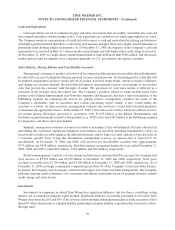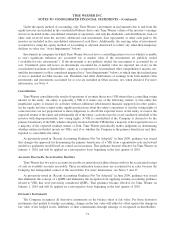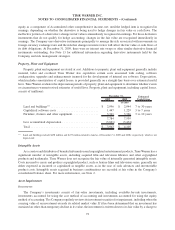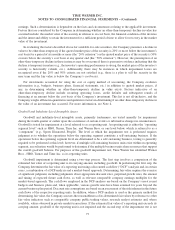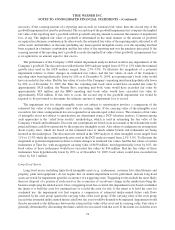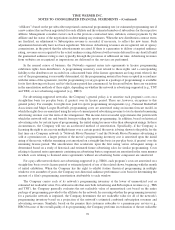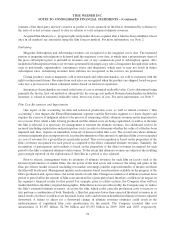Time Magazine 2009 Annual Report Download - page 81
Download and view the complete annual report
Please find page 81 of the 2009 Time Magazine annual report below. You can navigate through the pages in the report by either clicking on the pages listed below, or by using the keyword search tool below to find specific information within the annual report.Recent Accounting Guidance Not Yet Adopted
Amendments to Accounting for Transfers of Financial Assets and VIEs
In June 2009, guidance was issued that (i) eliminates the concept of a qualifying special-purpose entity
(“QSPE”), (ii) eliminates the exception from applying existing accounting guidance related to VIEs that were
previously considered QSPEs, (iii) changes the approach for determining the primary beneficiary of a VIE from a
quantitative risk and reward model to a qualitative model based on control and (iv) requires the Company to assess
each reporting period whether any of the Company’s variable interests give it a controlling financial interest in the
applicable VIE. This guidance became effective for Time Warner on January 1, 2010 and will be applied on a
retrospective basis beginning in the first quarter of 2010.
As a result of this guidance, the Company will no longer be deemed the primary beneficiary of HBO Asia, HBO
South Asia and HBO LAG. Beginning in the first quarter of 2010, the Company will account for its investments in
these entities using the equity method and will no longer consolidate their financial condition and results of
operations. The adoption of this guidance with respect to these entities will result in an increase (decrease) to
revenues, operating income (loss) and net income (loss) attributable to Time Warner Inc. shareholders of
($397) million, ($75) million and $9 million, respectively, for the year ended December 31, 2009 and an
increase (decrease) of ($82) million, ($16) million and $4 million, respectively, for the year ended
December 31, 2008. As of and for the years ended December 31, 2009 and 2008, the impact to the
consolidated balance sheet and statement of cash flows, respectively, will not be material.
Also, as a result of this guidance, beginning in the first quarter of 2010, the Company will consolidate its two
accounts receivable securitization facilities. The adoption of this guidance will result in an increase to accounts
receivables and debt due within one year of $805 million as of December 31, 2009 and 2008. In addition, for the year
ended December 31, 2008 and 2007, cash provided by operations will increase (decrease) by $231 million and
($113) million, respectively, with an offsetting (decrease) increase to cash used by financing activities. There will
not be any change to cash provided by operations for the year ended December 31, 2009. The impact on the
statement of operations will not be material. For more information, see Note 7.
Summary of Critical and Significant Accounting Policies
The following is a discussion of each of the Company’s critical accounting policies, including information and
analysis of estimates and assumptions involved in their application, and other significant accounting policies.
The Securities and Exchange Commission (“SEC”) considers an accounting policy to be critical if it is important to
the Company’s financial condition and results of operations and if it requires significant judgment and estimates on the
part of management in its application. The development and selection of these critical accounting policies have been
determined by Time Warner’s management and the related disclosures have been reviewed with the Audit and Finance
Committee of the Board of Directors. Due to the significant judgment involved in selecting certain of the assumptions
used in these areas, it is possible that different parties could choose different assumptions and reach different conclusions.
The Company considers the policies relating to the following matters to be critical accounting policies:
• Impairment of Goodwill and Identifiable Intangible Assets (see pages 73 to 74);
• Multiple-Element Transactions (see page 79);
• Income Taxes (see pages 80 to 81);
• Film Cost Recognition and Impairments (see pages 78 to 79);
• Gross versus Net Revenue Recognition (see pages 79 to 80); and
• Sales Returns, Pricing Rebates and Uncollectible Accounts (see page 70).
69
TIME WARNER INC.
NOTES TO CONSOLIDATED FINANCIAL STATEMENTS – (Continued)


